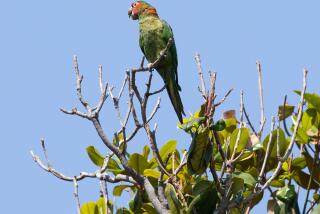Endangered Puerto Rican Parrots Get Chance at Survival
- Share via
CARIBBEAN NATIONAL FOREST, Puerto Rico — Raucous squawking erupts from cages filled with parrots -- a hopeful sound from a species on the brink of extinction.
The last chance of survival for the Puerto Rican parrot may lie in forest aviaries where these captive birds began their closely observed nesting in January.
Researchers estimate that 30 to 35 Puerto Rican parrots remain in the wild, making it one of the world’s 10 most endangered birds.
Parrots across the Caribbean are similarly vulnerable after centuries of deforestation and trapping for the pet trade. From the Cayman Islands to the Dominican Republic, many species are rare, threatened or dwindling in numbers.
But in the last 30 years, some conservation efforts across the Caribbean have shown modest success. In Puerto Rico, researchers say that if they keep increasing the captive population of native parrots, the species could make a comeback.
“The more we breed here, the more we can release in the wild,” said Bryann Ybarra-Weckmann, a U.S. Fish and Wildlife Service worker who feeds and monitors parrots at one of the island’s two aviaries. “Last year, we had our most successful breeding season ever. Ten birds survived.”
All of the 159 captive Puerto Rican parrots will stay in the aviaries at least until next year, when a select group will be released after receiving training on how to forage for food and avoid predators.
Bright green with a red forehead and wings that flash turquoise in flight, the Puerto Rican parrot was called “Iguaca” by the Taino Indians after the sound of its squawk.
The bird was plentiful when Columbus arrived in the Americas and coexisted with a Puerto Rican macaw and parakeet that have since died out. Now the parrot can be seen only in the Caribbean National Forest, a mountain rain forest known to Puerto Ricans as El Yunque.
Posters with photographs of the birds raise tourists’ hopes that they’ll see one, but few do. The parrot aviary is closed to the public.
Although flocks of parrots can be seen flying over San Juan, the U.S. territory’s capital, experts say those are nonnative varieties that have escaped from cages or been released over the years by pet owners.
The captive breeding program set up more than three decades ago has helped lift the Puerto Rican parrot population from a low point in 1975, when 13 wild birds were recorded.
Forty parrots raised in captivity have been released since 2000, and next year more will be freed to establish a second wild population in the island’s western Rio Abajo forest, near the second aviary, which is run by Puerto Rico’s Department of Natural Resources.
In the meantime, eggs are appearing in nests inside the aviaries, and for the next five or six months, researchers will be watching closely for hatchlings. Biologists have installed gaping plastic tubes on parrots’ cages and have laid wood chips inside to resemble nesting spots in the cavities of the palo colorado, the main parrot nesting tree.
Helping the birds reach maturity is painstaking work. Ybarra-Weckmann said he had hand-fed many chicks. A veterinarian who specializes in parrots has saved some sick birds, but others have died from infections.
When released, parrots are fitted with radio transmitters to track their movements.
Some are killed by predators such as red-tailed hawks. Hurricanes also pose a major threat. In 1989, Hurricane Hugo cut the wild population from 47 to about 23, said Jafet Velez, a biologist with the Fish and Wildlife Service.
Thieves also have snatched parrots for the pet trade.
Across the Caribbean, strict anti-smuggling laws and public awareness campaigns have helped curtail the illegal trade in parrots since the 1970s.
But researchers remain concerned about the fate of many species, largely because of the cutting of forests for construction and agriculture.
More to Read
Sign up for Essential California
The most important California stories and recommendations in your inbox every morning.
You may occasionally receive promotional content from the Los Angeles Times.













